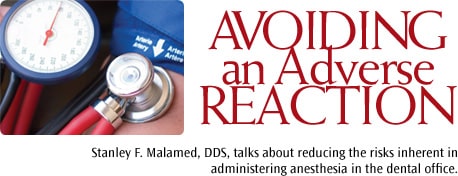
Avoiding an Adverse Reaction
Stanley F. Malamed, DDS, talks about reducing the risks inherent in administering anesthesia in the dental office.
Q. What are the risks associated with delivering anesthesia?
A. As with the administration of any drug, there are always possible complications and adverse events that may occur. Systemic reactions such as overdose (toxic reaction) to either the local anesthetic or vasoconstrictor; allergy; psychogenic reactions, such as syncope (loss of consciousness resulting from insufficient blood flow to the brain) and hyperventilation; and localized reactions, including trismus, broken needles, paresthesia, and soft tissue necrosis are all possibilities, however remote their actual occurrence.
Q. Are there steps to follow to minimize risks?
A. Proper administration of local anesthetics can minimize the occurrence of these complications, but nothing can absolutely guarantee they will not occur. However, proper patient evaluation before the start of the procedure, including a review of the medical history questionnaire, dialogue history, and monitoring of vital signs, can help identify patients who are at greater risk of developing problems. Treatment may either be deferred until a patient at risk for complications becomes healthier or treatment modifications may be instituted to minimize the risk. Vital signs should always be recorded prior to any drug administration, including local anesthetic via injection or even topically. Proper positioning of the patient is helpful in preventing psychogenic reactions such as syncope. Slow administration of the local anesthetic following two negative aspirations can prevent or minimize the seriousness of an adverse reaction secondary to intravascular injection. When treating lighter weight patients (either pediatric or geriatric), knowing the weight of the patient and limiting the dosage of both the local anesthetic and vasoconstrictor can minimize the occurrence of overdose, secondary to administration of too much drug.
BLOOD PRESSURE PROTOCOL
Q. Is it necessary to take the blood pressure of each patient before administering a local or topical anesthetic?
A. When a local anesthetic is being administered, the answer is an emphatic yes. In my opinion, heart rate/rhythm should be monitored as a routine part of all dental visits. How ever, the reality is different. Dental insurance carriers have reported that only 2% of general dentists record vital signs on a regular basis. It is the standard of care within the medical profession to record vital signs prior to the injection of any drug.
COMMON ADVERSE REACTIONS
Q. What are the most common adverse effects to an anesthetic agent?
A. It is not actually the drug that produces the most common adverse event, it is the needle. Two psycho genic reactions —syncope and hyperventilation— are a response to the act of receiving the injection, not to the actual drug being given. By far, the injection causes the most complications associated with drug administration in dentistry. In a survey I published in 1993, syncope accounted for slightly more than 50% of more than 30,000 medical emergencies experienced by more than 4,300 dentists.1 Additionally, the stress associated with receiving the injection may exacerbate any pre-existing medical condition, such as asthma, angina, and seizure disorders (epilepsy).
TOPICAL ANESTHETICS
Q. Can adverse reactions occur with the use of topical anesthetics?
A. Yes, though rarely. Ester-type topicals (benzocaine, tetracaine) can produce localized allergic reactions, usually manifested as soft tissue swelling, urticaria, and pruritus at the site of application. This is not a problem with the amide-type topicals, for example those containing lidocaine or prilocaine. In rare cases tissue sloughing could occur, though this is extremely rare. It would be due to the higher concentration of the drug being used as a topical (20% benzocaine, 5% lidocaine).
Q. Are there any precautions needed with the use of topical anesthetics that are applied/delivered subgingivally?
A. I cannot think of any special precautions necessary for the subgingival application of topicals.
HIGH RISK PATIENTS
Q. Are certain patients at higher risk for an adverse reaction, ie, male vs female, geriatric, pediatric, etc?
A In all situations related to drug administration patients at either end of the “bell-shaped curve” tend to be more susceptible to drugs. That is the reason why pediatric and geriatric drug dosages are usually decreased. With topical anesthetics used properly (small amounts) this should not pose a problem or increased risk to either of these patient groups.
Q. What can dental hygienists do to calm a patient who is anxious about the administration of anesthesia in order to prevent a psychogenic reaction?
A. Personality and chairside manner are key. Here at the University of Southern California, we call this iatrosedation— the calming of the patient by the health care provider’s behavior. Being aware of the patient’s fears, addressing them, and then assuring the patient that the local anesthetic will be administered comfortably and doing so. If it is available, the concurrent administration of nitrous oxide is strongly recommended.
Q. How commonplace are adverse reactions to anesthetic agents?
A. The answer is that adverse reactions to local anesthetics are very rare occurrences providing that care is taken in evaluating the patient prior to drug administration, and care is taken during the administration of the drug.
BE PREPARED
Q. What should all dental hygienists have at their fingertips just in case?
A. 1. Basic life support training
2. Compassion
3. Empathy
4. Knowledge of local anesthetic administration technique and specific knowledge of each technique being employed.
5. Oxygen
6. Ammonia vaporole (smelling salts)
REFERENCE
- Malamed SF. Managing medical emergencies. J Am Dent Assoc. 1993;124:40-53.
From Dimensions of Dental Hygiene. January 2009; 7(1):24, 26.

